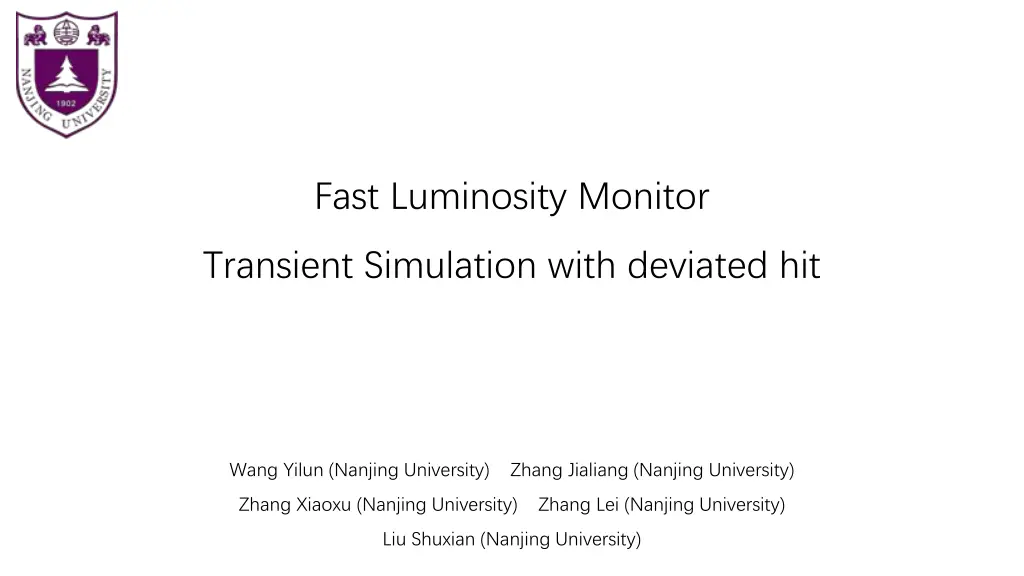
Fast Luminosity Monitor Transient Simulation with Deviated Hit
"Explore the fast luminosity monitor transient simulation with deviated hit, conducted by researchers from Nanjing University. Learn about the geometry, doping, I-V characteristic curve, transient simulation, and more. Discover the use of diamond detectors and the physics involved in this innovative monitoring technology."
Uploaded on | 2 Views
Download Presentation

Please find below an Image/Link to download the presentation.
The content on the website is provided AS IS for your information and personal use only. It may not be sold, licensed, or shared on other websites without obtaining consent from the author. If you encounter any issues during the download, it is possible that the publisher has removed the file from their server.
You are allowed to download the files provided on this website for personal or commercial use, subject to the condition that they are used lawfully. All files are the property of their respective owners.
The content on the website is provided AS IS for your information and personal use only. It may not be sold, licensed, or shared on other websites without obtaining consent from the author.
E N D
Presentation Transcript
Fast Luminosity Monitor Transient Simulation with deviated hit Wang Yilun (Nanjing University) Zhang Jialiang (Nanjing University) Zhang Xiaoxu (Nanjing University) Zhang Lei (Nanjing University) Liu Shuxian (Nanjing University)
Contents Introduction Geometry & Meshing Doping & I-V Characteristic Curve Transient Simulation Conclusion
Introduction Fast Luminosity Monitor is used to give bunch luminosity at CEPC Integrated event rates along z-position can help monitoring z-position at IP Polar angle ?~10 ????, highest radiation field at CEPC Detect small angle Bhabha events Electron showers generated in the copper beam pipe Diamond is used for detector Single crystal Chemical Vapor Deposition (sCVD), reducing defect densities High carrier mobility : 2000~2800 ??2? 1? 1 Wide bandgap, low dark noise : 5.47 ?? Strong covalent bonds, high radiation hardness 3 3
Geometry Same as the 4-strip diamond, 6000 6000 260 ?? (? ? ?) 4 electrodes on front side, each 1100 5000 ?? (? ?) One electrode on back side, 5000 5000 ?? (? ?) All electrodes are ohmic contact 4 4
Meshing Meshing focus on the center of detector Smaller mesh around hit position Region 1 ? ? ? (??) 2 2 2 ~ 5 5 10 2 2 0.5 ~ 5 5 2 around electrode Region 2 ? ? ? (??) Region 2 0.5 0.5 1 ~ 1 1 4 Region 1 0.5 0.5 0.5 ~ 1 1 1 around electrode 5 5
Physics Physics { EffectiveIntrinsicDensity( OldSlotboom ) # doping bandgap narrowing effect Mobility( -ConstantMobility DopingDep HighFieldSaturation( Eparallel ) # Removed to match experiment results Enormal # Removed, no effect ) Recombination( SRH( DopingDep ) Avalanche ) HeavyIon( Direction = (0,0,1) Location = (0,0,-260) Time= 1e-9 Length = 520 Wt_hi = 1 LET_f = 5.767e-6 Gaussian PicoCoulomb ) } # do not use ConstantMobility model # doping dependent Shorkley-Read-Hall recombination 6 6
Doping & I-V Characteristic Curve During CVD process, Boron and Nitrogen are common impurities Add 45 ?? 3Boron Active Concentration to match experiment result 7 7
Doping & I-V Characteristic Curve Instead of changing the ActiveBoronConcentration from 1010to 45 ?? 3, Adding traps can arrive at the same results Experiment uses pCVD diamond 8 8
Physics with Traps Physics { EffectiveIntrinsicDensity( OldSlotboom ) # doping bandgap narrowing effect Mobility( -ConstantMobility DopingDep HighFieldSaturation( Eparallel ) # Removed to match experiment results Enormal # Removed, no effect ) Recombination( SRH( DopingDep ) Avalanche ) Traps( ( Donor Level fromCondBand EnergyMid=0.05 Conc=1.65e10 eXsection=1e-13 hXsection=1e-18 ) ( Donor Level fromCondBand EnergyMid=1.0 Conc=1.65e10 eXsection=1e-15 hXsection=1e-18 ) ( Acceptor Level fromCondBand EnergyMid=2.2 Conc=1.65e10 eXsection=5e-16 hXsection=1e-13 ) ) HeavyIon(...) } # do not use ConstantMobility model # doping dependent Shorkley-Read-Hall recombination 9 9
Transient Simulation 10 10
Transient Simulation - Physics Physics { EffectiveIntrinsicDensity( OldSlotboom ) Mobility( -ConstantMobility DopingDep ) Recombination( SRH( DopingDep ) Avalanche ) HeavyIon( Direction Location Time = 1e-9 Length = 520 Wt_hi = 1 LET_f = 5.767e-6 Gaussian PicoCoulomb ) } Electrode 2 Electrode 3 = (0,0,1) = (@x0@,0,-260) (parameter) 11 11
200 V, 2 um 12 12
200 V, 5 um 13 13
200 V, 10 um 14 14
400 V, 2 um 15 15
400 V, 5 um 16 16 5 um
400 V, 10 um 17 17
For further hits, shifting mesh to cover the hit position is required Otherwise, the total charge ionized will be wrong The picture below shows the mesh centered at ? = 60?? 18 18
200 V, 30 um 19 19
200 V, 60 um 20 20
400 V, 30 um 21 21
400 V, 60 um 22 22
Conclusion Fast luminosity monitor uses sCVD diamond, for its high carrier mobility, wide bandgap and high radiation hardness The geometry of the diamond is built, same as the real device Either doping be set to 45 ?? 3, or 1010?? 3with traps, to reach the same IV results as experiment Transient simulations of particle hitting the detector with different deviations are performed, the signal produced is drawn 23 23
